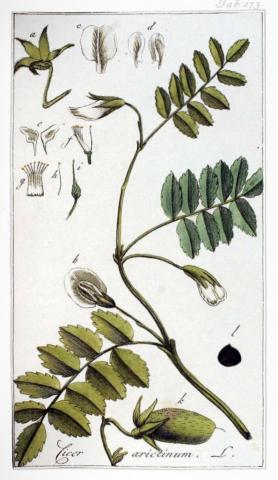Cicer arietinum

| Common Name | Chickpea
|
|---|---|
| Genus | Cicer
|
| Species | arietinum
|
| Ploidy | Diploid
|
| Chromosome Number | 2n = 16
|
| Genome Size | ~740 Mbp
|
| Taxonomy | cellular organisms; Eukaryota; Viridiplantae; Streptophyta; Streptophytina; Embryophyta; Tracheophyta; Euphyllophyta; Spermatophyta; Magnoliophyta; Mesangiospermae; eudicotyledons; Gunneridae; Pentapetalae; rosids; fabids; Fabales; Fabaceae; Papilionoideae; Cicereae; Cicer
|
There are three main kinds of chickpeas: Desi, which has small, darker seeds and a rough coat; Bombay, which has slightly larger dark seeds; and Kabuli, which has lighter coloured seeds with a smooth coat. Chickpeas are an excellent source of the essential nutrients, iron, folate, phosphorus, protein and dietary fiber. Chickpeas are low in fat and most of this is polyunsaturated. Desi chickpeas have a markedly higher fiber content than Kabulis and hence a very low glycemic index which may make them suitable for people with blood sugar problems. The plant grows to between 20–50 cm high and has small feathery leaves on either side of the stem. Chickpea pods are short in length containing 2-3 seeds.
-
 Bunyamin Tar'an:
Breeding chickpea and faba bean varieties and conducting related research in collaboration with colleagues.
Bunyamin Tar'an:
Breeding chickpea and faba bean varieties and conducting related research in collaboration with colleagues.
